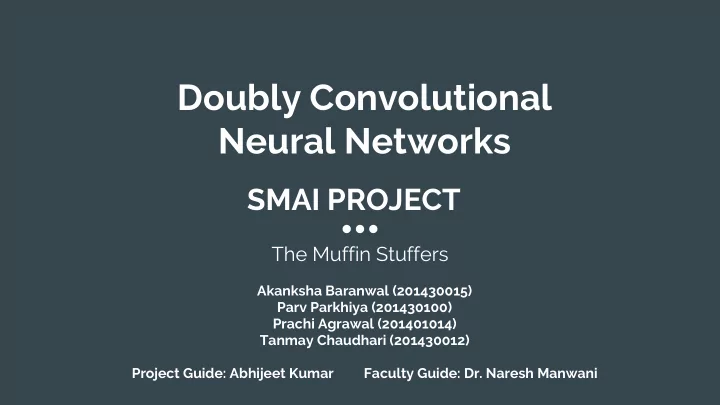

Doubly Convolutional Neural Networks SMAI PROJECT The Muffin Stuffers Akanksha Baranwal (201430015) Parv Parkhiya (201430100) Prachi Agrawal (201401014) Tanmay Chaudhari (201430012) Project Guide: Abhijeet Kumar Faculty Guide: Dr. Naresh Manwani
AIM Parameter sharing is the major reason of success of building large models for deep neural networks. This paper introduces the idea of Doubly Convolutional Neural Networks , which significantly improves the performance of CNN with the same number of parameters.
Neural Network
Convolutional Neural network CNNs are extremely parameter efficient due to exploring the translation invariant property of images, which is the key to training very deep models without severe overfitting.
K-Translation Correlation In well trained CNNs, many of the learned filters are slightly translated versions of each other. K-translation correlation between two convolutional filters within same layer W i , W j is defined as: Here, T(.,x,y) denotes the translation of the first operand by (x,y) along its spatial dimensions. K-translation correlation between a pair of filters indicates the maximum correlation achieved by translating filters up to k steps along any spatial dimension. For deeper models, averaged maximum k-translation correlation of a layer W is: N is the number of filters
Correlation Results The averaged maximum 1-translational correlation of each layer for AlexNet and VGG Net are as follows. As a comparison, a filter bank with same shape filled with random gaussian samples has been generated. ALEXNET LAYERS
VGG-19 first nine layers
Group filters which are translated versions of each other. DCNN allocates a set of meta filters Idea of DCNN Convolve meta filters with identity kernel Effective filters extracted
Convolution Input image: Set of c l+1 filters : each filter of shape: c l x z x z Output image:
Double Convolution Input image: Output image: Set of c l+1 meta filters: with filter size z’xz’, z’>z Spatial pooling function with pooling size s x s
Set of c l+1 meta filters size (z’ x z’) Image patches size (z x z) convolved with each meta filter Output size (z’-z+1) x (z’-z+1) Working of DCNN Spatial pooling with size (s x s) Output flattened to column vector Feature map with nc l+1 channels
Double Convolution: 2 step convolution STEP1: An image patch is convolved with a metafilter. STEP2: Meta filters slide across to get different patches, i.e. convolved with the image.
ALGORITHM
Implementation & Results
MNIST DATASET Input: 1x28x28 (GrayScale Image) Class: 10 (0,1,2, … , 9) Train Samples: 60,000 Test Samples: 10,000
Batch Size: 200 Epochs: 100 Dropout: Yes Minimum Error Values: DCNN Train: 0.032 at 97 DCNN Test: 0.01 at 13 CNN Train: 0.025 at 97 CNN Test: 0.009 at 70
DCNN vs CNN Test Test Batch Epochs Pool Dropout Error Error Size DCNN CNN 10 2 200 No 0.0137 0.019 9 1 100 No 0.018 0.017 10 2 200 Yes 0.0153 0.0171 Conclusion: Even though DCNN has 360 params compare to CNN which as 1650 params, Test Error is almost comparable. Forward Pass Run is Faster in DCNN. Convergence for DCNN is much faster and after that overfitting happens quickly compare to CNN
Variants of DCNN Standard CNN Concat DCNN Maxout DCNN z’=z s=1 s=z’-z+1 DCNN is generalisation of CNN Maximally parameter efficient Output image channel size equal to the number of meta With the same amount of filters. parameters produces (z’-z+1) 2 z 2 Yields a parameter efficient z’ 2 implementation of maxout times more channels for a single network. layer.
What’s Next? Instead of translational correlation modeling for Rotational Correlation. ● Mechanism to decide number of meta filters and its size . ●
References Our Github Repo: https://github.com/tanmayc25/SMAI-Project---DCNN ● ● Doubly Convolutional Neural Networks (NIPS 2016) by Shuangfei Zhai, Yu Cheng, Weining Lu and Zhongfei (Mark) Zhang https://papers.nips.cc/paper/6340-doubly-convolutional-neural-networks.pdf Getting Started with Lasagne: ● http://luizgh.github.io/libraries/2015/12/08/getting-started-with-lasagne/ ● Lasagne Docs: https://lasagne.readthedocs.io/en/latest/ Theano Docs: http://deeplearning.net/software/theano/library/index.html ●
Recommend
More recommend